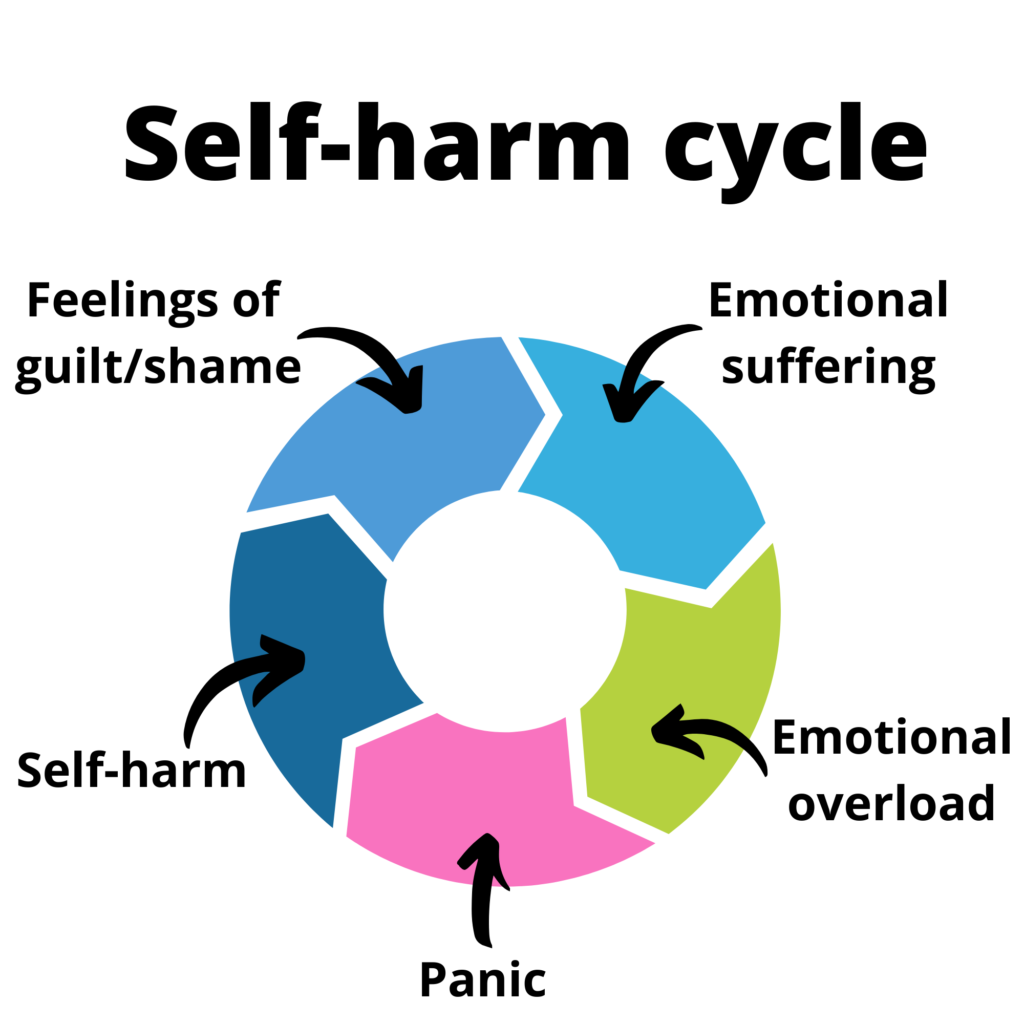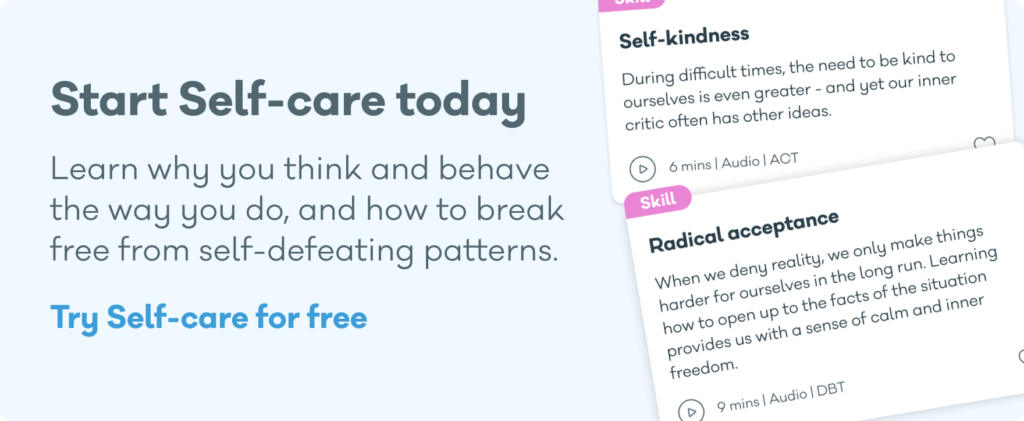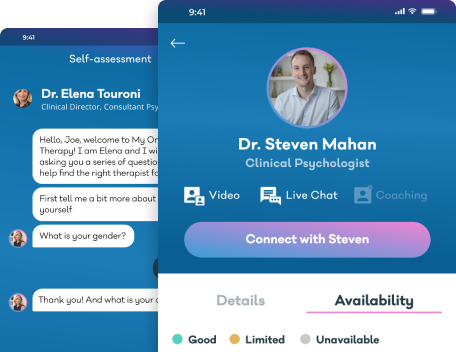Warning: it can be upsetting and potentially triggering to read information about self-harm. If you are feeling vulnerable at the moment, you might want to revisit this blog at another time.
We know how difficult it can be to talk about self-harm. In the past, you might have dodged probing questions, hidden your scars, or withdrawn from friends and family in an attempt to avoid the conversation. So, right now, you’re taking a big step. Simply admitting that you struggle with self-harm takes guts, so you should be proud of how far you’ve come.
There are plenty of resources you can draw upon, and today, more than ever, you may start to see that you’re not fighting this battle on your own.
That’s because it’s Self-harm (or Self-injury) Awareness Day (1 March) — a day where people open up and share their own stories of self-harm, dispel the myths behind it, and share resources to help people cope with harmful urges.
What is self-harm?
Self-harm is any behaviour you carry out as a way to intentionally or immediately hurt yourself. This typically refers to when you physically hurt yourself by cutting, burning or scratching, for example. Although, it can also can include risky behaviour such as consuming toxic amounts of alcohol and drugs or deliberately participating in unsafe sex.
That being said, it’s also possible to engage in emotional self-harm. For instance, you might purposefully date non-committal partners.
However, for sake of clarity, in this article we’re focusing on the physical act of self-harm.
Some people self-harm sporadically — in moments they’re experiencing significant distress — whereas others self-harm frequently, sometimes several times a day. Self-harm is not a diagnosable mental health condition in itself but it’s usually a symptom of deeper mental or emotional distress.
Sadly, it’s a problem that more and more people face too.
Research from the NHS suggests that one in four young women and one in ten young men have self-harmed at some point during their lives. And, during the first lockdown, nearly one fifth (18%) of people surveyed reported having thoughts of self-harm or suicide, according to the British Journal of Psychiatry.
Why do people self-harm?
You might find it difficult to put a finger on why you self harm. When you started self-harming, you probably didn’t want to really hurt yourself. This is because self-harm is more than the physical act — it’s usually a way to deal with overwhelming emotional distress.
Some people use self-harm as a form of self-punishment or as a way to stop painful feelings of numbness or disassociation. Others use it as a way to make an invisible emotional pain visible.
Alternatively, some people use self-harm as a way of dealing with difficult feelings, painful memories or overwhelming situations and experiences. And very often, it’s a combination of these factors.
Common self-harm triggers
There are plenty of stressors that may trigger someone to self-harm. Common reasons include (but are not limited to):
- Bereavement
- Bullying
- Peer pressure
- Relationship difficulties
- Exam stress
- Confusion about sexuality and gender
- Low self-esteem
- Financial difficulties
- Mental health difficulties such as anxiety and depression
What is the self-harm cycle?
Some people use self-harm as a way to release any painful feelings or thoughts they may be carrying.
But, the reality is, self-harm carries risks. And even if it offers a short-term release, the real root of your distress is unlikely to have gone away.
Self-harm can also bring up very difficult emotions. After hurting yourself you may feel shame and guilt. You may even feel worse than what you did to begin with, which can ultimately lead to more urges to self-harm.
People often describe this as ‘the self-harm cycle’.

Common misconceptions about self-harm
Self-harm Awareness Day also hopes to dispel the common myths and misconceptions about self-harm. Because let’s face it, there’s a lot of them.
Here are just a few you may have heard:
MYTH: ‘Only teenage girls self-harm’
When it comes to self-harm, media coverage often centres on young people, particularly young women. Emergency services do receive more self-harm related calls from women than men, However, research suggests that men may be just as likely to hurt themselves. It’s just that they face cultural barriers that discourage them from reaching out for help.
With this in mind, it’s important to note that, whilst young women are a high-risk group, men self harm too. This is a widespread problem that affects people from all walks of life. There’s no ‘typical person’ who hurts themselves. Because it doesn’t matter whether you’re young or old, male or female, anyone can self-harm.
MYTH: ‘It’s just attention-seeking’
Some people dismiss self-harm as a ‘phase’ or ‘attention-seeking’. But snide remarks like these help no one, and they probably leave you feeling judged and alienated.
The truth is a lot of people keep their self-ham private. They do it behind closed doors and make pained efforts to hide it from friends and family — and it can be a lonely, isolating experience.
Other people do use self-harm as a way to get attention — and that’s completely okay too. Remember that there’s nothing wrong with wanting to be seen. You deserve to have your emotional distress taken seriously. Self-harm is oftentimes a cry for help.
MYTH: ‘People who self-harm are suicidal’
Sadly, some people self-harm because they want to take their own lives, but this isn’t always the case. For many, self-harm may even be a means of avoiding suicide.
Nonetheless, people who have self-harmed in the past 12 months are statistically at greater risk of suicide. That’s why it should always be taken seriously. Even if you don’t think it’s a problem, it’s vital that you reach out for help.
Tips for coping with self-harm now
There is no fix or magic solution when it comes to self-harm. Breaking these unhelpful patterns can take time, and there might be moments where you cave to your urges. That’s okay.
Be kind to yourself and practice self-compassion. Even if you make some progress and slip into old habits, remind yourself it isn’t a failure. It’s simply part of the process.
During intense urges to hurt yourself, it can be hard to imagine that it’s possible to do anything else.
But there are steps you can take to cope. Here are a few tips that may help. Some of these may work, others may not, it’s about finding what’s best for you.
Confide in someone
If you’re ready to get help, the first step is to confide in another person. Doubts are normal, but being open and honest about what you’re going through will help you get the support you need.
It might seem scary to open up about something you may have tried so hard to hide. But chances are you’ll feel a huge sense of relief once you get this off your chest.
It’s important that you speak to someone you can trust, such as a close friend or a relative. Or if there’s no one in your life you feel comfortable chatting to, remember that you can always speak to a professional such as your GP, a charity or a therapist.

When explaining what’s going on, communicate in whatever way makes you comfortable. Pick a time when you and your loved one are in a calm, stable mood. This can be tricky, but choosing a time when you’re sober, well-rested and in a safe environment is more than enough. And don’t feel pressured into disclosing things or showing injuries if you’re not ready to.
Expressing the feelings that led to your self-harm might help the other person better understand what you’re going through. As difficult as it is for you to open up about your self-harm, remember that it may also be difficult for the person you tell — especially if it’s a close friend or family member.
If they react badly or with anger, don’t let this dishearten you. You’re going through some difficult emotions at the moment and don’t deserve to be scolded. So don’t let this stop you from reaching out again.
Understanding the underlying reasons why you self-harm
For a lot of people, self-harm is just the tip of the iceberg and there are deeper issues at play.
With this in mind, the first step to tackling self-harm involves sifting through your emotions and seeing where this hurt stems from. To solve self-harm you need to solve the underlying issue, which usually requires the support of a professional.
To get started though, it may be helpful to ask yourself the following questions:
- What feelings make you want to cut or hurt yourself? Is it sadness, anxiety, loneliness, shame or anger, for instance? If you’re having a hard time pinpointing your feelings, it may be worth working on your emotional awareness.
- Do you have any specific triggers? Perhaps you notice that the urge to self-harm arises when someone makes a comment about your appearance? Or maybe a difficult situation at work sends you into a negative tailspin?
It might even be more subtle. You might discover that you have a tendency to self-harm after drinking or when you haven’t had enough sleep.
Ultimately, you may not be able to avoid all triggers, but knowing what sets off your urges can help you prepare should the situation arise again.
Start therapy
Behind self-harm, there are often uncomfortable or painful emotions that you need to untangle first. That’s why therapy —and specifically talking therapies — can make such a big difference.
A psychologist will help you explore these approaches and find the right ones that work for you. In your session, they’ll use evidence-based techniques to work through why you feel the need to self-harm and help you manage these feelings, all within a safe and understanding environment.
Ride the wave of your urges
Stopping self-harming behaviours is easier said than done. That’s because, even when you want to stop, urges can be very strong and persuasive. Your first instinct might be to battle against them. But often fighting the urge only feeds it and makes it stronger.
Just like an itch, the more we try to stop ourselves from touching it, the itchier it feels and the more we want to scratch it.
The reality is, urges rarely last very long. So if we can resist them for a bit, they’ll quickly peter out.
Think of urges a bit like waves in the sea. They slowly rise, getting bigger and stronger before they peak. But, inevitably, they crash and fade away. We could try to fight the wave of our urges. But a better tactic might be ‘urge surfing’.
This is a therapy technique whereby you don’t fight or try to suppress your instinct to self-harm, instead you ride the wave of your urge. You allow yourself the time and space to experience the urge. Because, you know that if you can resist it, it’ll eventually fade away in its own time. For more advice on this, check out ‘Urge Surfing’ in Self-care, our audio and video library.
Distraction
Urges are a difficult beast. When faced with these challenging emotions we can ground ourselves in the present moment and try to work through them.
But if they get too much, another short-term solution might be to momentarily distract yourself so that you don’t engage in self-harm.
Some distractions include:
- Exercise
- Dancing
- Walking in nature
- Holding ice cubes
- Reading a book or watching a movie
- Calling a friend and talking to them, even if it isn’t about self-harm
- Have a good scream into a pillow or cushion
- Writing down some distressing feelings on a piece of paper and tearing it up
- Doing something creative to express how you’re feeling
Remember, distraction can be great in the moment — when we’re feeling too overwhelmed to think or behave in line with our values — but, ultimately, it’s just a short-term solution.
You can’t avoid or suppress these feelings forever, so make sure you take concerted efforts to work through them, for instance, in therapy.
Avoid alcohol or drugs
Numbing painful emotions can be tempting. But try to avoid alcohol and drugs. Chances are, when the initial buzz wears off, you’ll end up feeling worse than you did before.
They can leave you feeling depressed or anxious, lower your inhibitions and may ultimately lead to self-harm.
Look after yourself physically
Self-harm isn’t something to downplay. You may feel like you have it under control, particularly if it’s an everyday habit. But it’s easy to end up with an infected wound or misjudge the depth or a cut — especially if you’re under the influence of alcohol or drugs.

If you’re ever worried about an injury from self-harm, it’s important you speak to a doctor, and in an emergency, you should always call 999.
Remember that you’re never being a burden. Your welfare is paramount.
The idea of recovery might seem a little daunting at first. Your urges might feel overwhelming but, with time, you can learn to manage them until they eventually subside.
Even if it has become an everyday habit, it is possible to break free from the cycle of self-harm — and you don’t have to do it alone. Show yourself some self-compassion and remember that no matter how difficult things get, there is always hope.

